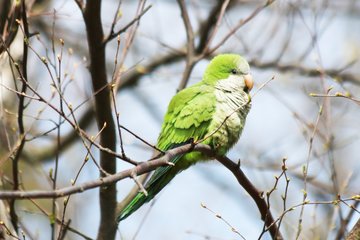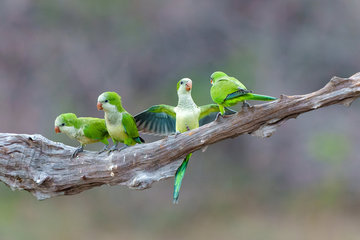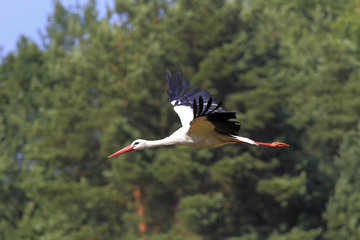Surviving amongst cannibals
Locusts move in swarms to avoid falling victim to their conspecifics
It may soon be easier to combat locust plagues. An international research team including members from the Max Planck Institute for the Physics of Complex Systems clarified further details of how these insects, which are actually solitary creatures, form swarms. Especially in Africa, the masses of locusts repeatedly destroy large portions of harvests. As the working group discovered in a computer simulation, cannibalism, which is common among locusts, causes the insects to move across the land in swarms once a certain population density is reached. This behavioural change keeps the risk of cannibalism as low as possible, specifically also in the dense throngs. They also discovered that the swarms do not disperse again until the locust density becomes very low – much lower, in any case, than that at which they form. This finding could help in preventing the formation of locust swarms early on.

Cannibalism is a widespread phenomenon in the animal kingdom. Among locusts, too, the enemy lurks within their own ranks. That is why they mostly avoid each other and spread out over extensive tracts of land to search for food. However, if the animals are forced to close up the ranks due to the food supply becoming scarce, then the risk of being eaten by a conspecific increases. As soon as the population density exceeds a critical value, the locusts form the devastating swarms. The current study of the Max Planck Institute for the Physics of Complex Systems, in cooperation with Princeton University, the Indian Institute of Science, Texas A&M University and the University of Sydney, will help to more reliably predict swarm formation in future and to combat such plagues.
The locust swarms form because the insects drastically change their behaviour: they transform from solitary individuals into gregarious individuals that move collectively. Biologists call such a change in one or more traits as a result of environmental influences "polyphenism". In desert locusts, the differences between the two types are so great that it was long thought that they were two different species – not least because the solitary individuals are green and the gregarious individuals exhibit a yellow-brown pattern.
Cannibalism explains why the locusts change their behaviour
Earlier studies had already shown that cannibalism is a driving force behind the collective movement of locusts. Even juvenile insects that are not yet able to fly begin moving in coordination on the ground – so their behaviour already resembles that of a swarm. In their search for food, a sort of forced march begins. As soon as the animals can fly, they continue the collective movement in the air. Insects that don't move with the flow run a greater risk of being attacked and eaten by their conspecifics. The ordered movement of the group thus ensures the locusts' survival.
But cannibalism is a key factor not only in swarm movement; it also provides an explanation as to why the locusts developed this polyphenism in their evolution in the first place, as a team of biologists, theoretical ecologists and physicists showed in their current study. The scientists designed a computer model that simulates the movement of the locusts. To do this, they created a fictitious locust population whose individuals can initially pursue various movement strategies. Later, the researchers set up the different behaviours to compete against each other on the computer in order to find, using a so-called evolutionary algorithm, the best strategy to minimize direct contacts with conspecifics, and thus the risk of cannibalism. "Here, it is important that we not prescribe how our locusts move," says Pawel Romanczuk, one of the study's authors from the Max Planck Institute in Dresden. "Because then we would merely have expressed our current observations in formulas."
Collective movement ensures the survival of the species
Using this model, the researchers discovered which movement pattern is optimal for keeping the risk of cannibalism with increasing population density as low as possible, thus ensuring the survival of the species. At just a few insects per square meter, they should largely avoid each other and move about as solitary individuals. According to the model, however, beyond a certain population density, the locusts give up their aloof behaviour and become more gregarious in order to ensure their survival. In the swarm, it proves to be the best strategy for each individual to follow the conspecifics that are moving away from it, and to flee from those that are approaching it. This results in collective movement. Overall, the locusts come closer together in the swarm, but due to the collective behaviour, they prevent any direct contact. This is precisely the change in behaviour that we observe in nature.
In addition to this fundamental finding, the study also produced a finding that may have a practical benefit: the locusts possess something like a memory. As soon as the locust density decreases, they return to behaving like solitary individuals and stay well clear of each other. As the simulation by Pawel Romanczuk and his colleagues showed, however, the threshold value for this behavioural change was much lower than that for swarm formation. "So, to disperse an existing swarm again, the locusts must be severely decimated," says Romanczuk. Today, usually the destructive swarms are combated first. "But it makes sense to keep the locust population small from the outset, avoiding swarm formation in the first place." This would also mean a lower pesticide burden on people and the environment.
SB/PH












